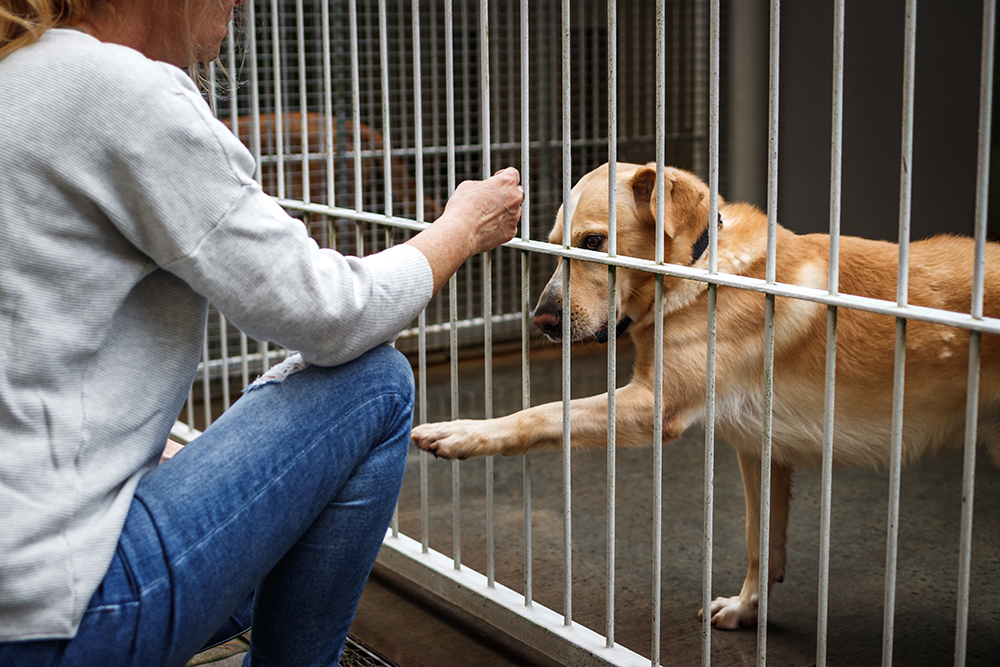Every dog deserves a chance to live a happy life. Unfortunately, there are hundreds of thousands of dogs waiting for their forever home at any given time. It’s hard for us animal lovers to hear stories of dogs waiting for months (or worse, years) in shelters, and sadly, many dogs will never find the loving home they deserve. We want to help, but what can we do if we’re not actively looking to adopt?
Helping dogs in need often comes down to supporting your local animal shelters and rescues. The dogs waiting for their forever homes

The 10 Great Ways to Help Dogs in Need
1. Volunteer

Volunteering at your local animal shelter, humane society, or rescue is a fantastic way to help dogs (and other animals) in need. Your tasks will vary depending on where you’re volunteering and your abilities, but you may be required to do jobs such as:
- Playing with the animals
- Walking the dogs
- Cleaning kennels
- Work at the reception desk
- Answer phones
- Do laundry
- Feed the animals
- Socialize the animals
- Clean cages
2. Foster
Fostering gives a second chance to an animal waiting for their forever home. It allows your local rescue or humane society more space in their facilities to save another animal. Foster parents are the backbone of many of your local rescue groups. Without a strong and reliable network of foster providers, rescues cannot take in as many animals as they’d otherwise be able to.
3. Donate Money

Animal shelters and rescues have bills to pay, and monetary donations will always be gratefully accepted. Your money may go toward covering the cost of the facility’s daily operations, paying staff members, buying supplies, training staff, and much more.
4. Donate Supplies
Running a rescue or shelter requires a lot of supplies and money to buy said supplies. Unfortunately, most rescues don’t have a plethora of extra cash to work with, so they rely on generous donations from the locals to see them through.
If you have extra dog supplies like food, bowls, or toys, your shelter will be happy to accept them. They also will take items like used towels, blankets, and sheets if you have any spare ones that would otherwise wind up in the dump.
Depending on how tech-savvy your rescue shelters are, some may have online “wish lists” of desperately needed items. These lists can be Amazon wish lists or similar.
Before you donate or buy anything specifically for your shelter, give them a call first to ensure what you’ll be bringing is something they require. Please remember that these organizations are not a dumping ground for your used junk or an alternative for your local dump. Be respectful, and don’t leave them with the burden of dealing with your garbage.
5. Fundraise

If you don’t have the cash to make a monetary donation right now, you can still raise funds for your shelter without spending a dime of your own money. Some great ideas for fundraising include:
- Organizing a silent auction. Ask local businesses and companies in your area for donations. Silent auctions can be run online or in person.
- Organizing a recycling drive. Place recycling bins in your office or apartment building. You can also make an event on social media websites and advertise the day and time you’ll be driving around the neighborhoods in your city picking up donations.
- Having a garage sale. Get rid of things cluttering up your home and donate proceeds (or the entire amount you make during your garage sale) to your shelter.
- Hosting a bake sale. If you’re a great baker, try organizing a local bake sale with proceeds (or the total amount made) going toward your shelter.
6. Sponsor a Dog
If you don’t have the time, money, or patience to adopt a new dog, how about sponsoring one? Rescues put a lot of time and resources into each animal they house, and you can ease the burden a bit by committing to paying a sponsorship fee for a particular dog waiting for their forever home. What this looks like exactly will depend upon your shelter, but it may look like daily, weekly, or monthly donations to go toward the specific dog you’ve chosen.
7. Offer Transportation

Shelters sometimes require drivers to transport pets. Offering your services for transportation will free up the shelter employees’ time so they can focus on finding homes for the animals in waiting. You may be required to drive pets to and from veterinary appointments or pick up donations and supplies from various places in your city.
8. Provide Free Advertising
Whether you have a social media following of 500 or 50,000 people, share the posts your local shelters make with your followers. Every single person who sees the posts is a potential adopter of the animals waiting for forever homes. So, the next time your local rescue makes a post advertising one of their adoptable animals or requesting supplies or donations, click “Share.” Even if no one in your circle of friends is looking to bring another animal into their home, they may be able to share it with someone who is in a place to adopt right now.
9. Offer Your Services

Are you a whiz with a digital camera? Host a pet photoshoot campaign by donation and have your customers donate food or money to the shelter instead of paying you directly. Do you know how to build a website and optimize SEO? Offer to help your rescue fix their website so it reaches more people. Perhaps you’re a master crocheter? Knit sweaters or blankets to help dogs waiting to be adopted stay cozy. Regardless of your talent, there’s certainly a way for you to harness it to support your local dogs in need.
10. Adopt a Dog
You can support your local dogs in need by adopting one, but only if you have the means and time to put toward your new pet. Take your time to find the dog that best suits your lifestyle and current living situation.

Conclusion
Helping dogs in need is an extremely rewarding endeavor that impacts not only the animals but also your community. Whether you decide to volunteer your time, make regular monetary donations, run fundraisers, or spread awareness, every little bit makes a difference in the lives of the animals waiting for their forever homes.
See Also:
- Dumping Dogs in the Country: What Really Happens to Them?
- Oakland TLC Program Teaches At-Risk Kids Empathy Toward Animals
Featured Image Credit: N_T, Shutterstock



















2 Responses
Dogs need happy lifes.
Hi Kat,
Absolutely, giving dogs happy, healthy lives is the ultimate goal! Every bit of care, love, and attention makes a huge difference for dogs in need.
Whether it’s volunteering, donating, fostering, or simply spreading awareness, every small action helps dogs live happier, safer lives.
Thanks for your comment!